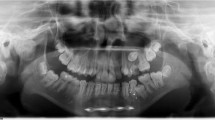Abstract
Background
Temporomandibular joint (TMJ) ankylosis is an extremely disabling affliction that causes problems in mastication, digestion, speech, appearance, and hygiene. The disease also has an impact on the psychological development of the patients.
Case report
A 49-year-old male patient came to our unit with complaint of restriction in his alimentation and of mouth opening. In the anamnesis, the patient reported that this limitation began 11 years ago, soon after a serious car accident that caused trauma on the face. In the clinical examination, the patient’s mouth opening was 1 mm, and there was satisfactory occlusion. He was diagnosed with bilateral temporomandibular joint (TMJ) ankylosis after an imaging examination.
Discussion
In order to confirm the post-traumatic etiology of the anquilose, we got the medical records from the hospital where the patient received the first treatment. The records, at that time, reported facial trauma with bilateral condylar fracture and comminuted symphyseal fracture which was reduced and fixed followed by maxillomandibular fixation that remained for 45 days. After collecting all the information needed for diagnosis, surgical treatment was proposed through arthroplasty. The patient was placed on immediate post-operative jaw physiotherapy, and 12 months after surgery, his mouth opening improved to 35 mm. Thus, in our case, ankylosis may have been developed as a sequel of the mandibular fractures.




Similar content being viewed by others
References
He D, Yang C, Chen M, Yang X, Li L (2012) Effects of soft tissue injury to the temporomandibular joint: report of 8 cases. Br J Oral Maxillofac Surg doi:10.1016/j.bjoms.2012.02.005
Roychoudhury A, Parkash H, Trikha A (1999) Functional restoration by gap arthroplasty in temporomandibular joint ankylosis: a report of 50 cases. Oral Surg Oral Med Oral Pathol 87:166–169
Sawhney CP (1986) Bony ankylosis of the temporomandibular joint: follow-up of 70 patients treated with arthroplasty and acrylic spacer interposition. Plast Reconstr Surg 77:29–40
Valentini V, Vetrano S, Agrillo A, Torroni A, Fabiani F, Iannetti G (2002) Surgical treatment of TMJ ankylosis: our experience (60 cases). J Craniomaxillofac Surg 13:59–67
Toyama M, Kurita K, Koga K, Ogi N (2003) Ankylosis of the temporomandibular joint developing shortly after multiple facial fractures. Int J Oral Maxillofac Surg 32:360–362
Friedman MH et al (1993) Postsurgical temporomandibular joint hypomobility: rehabilitation. Rev Cir Traumatol Buco-Maxilo-Fac 5(4):37–42
Ferretti C, Bryant R, Becker P, Lawrence PC (2005) Temporomandibular joint morphology following post-traumatic ankylosis in 26 patients. Int J Oral Maxillofac Surg 34:376–381
He D, Ellis E III, Zhang Y (2008) Etiology of temporomandibular joint ankylosis secondary to condylar fractures: the role of concomitant mandibular fractures. J Oral Maxillofac Surg 66:77–84
Rattan V (2002) Superolateral dislocation of the mandibular condyle: report of 2 cases and review of the literature. J Oral Maxillofac Surg 60:1366–1369
Vasconcelos BCE, Bessa-Nogueira RV, Cypriano RV (2006) Treatment of temporomandibular joint ankylosis by gap arthroplasty. Med Oral Patol Oral Cir Bucal 11:66–69
Hlawitschka M, Loukota R, Eckelt U (2005) Functional and radiological results of open and closed treatment of intracapsular (diacapitular) condylar fractures of the mandible. Int J Oral Maxillofac Surg 34(6):597–604
Eckelt U, Schneider M, Erasmus F, Gerlach KL, Kuhlisch E, Loukota R, Rasse M, Schubert J, Terheyden H (2006) Open versus closed treatment of fractures of the mandibular condylar process—a prospective randomized multi-centre study. J Craniomaxillofac Surg 34(5):306–314
Ethical approval
The approval of the Committee on Ethics in Research/CEP/UFMS granted approval of this work through the free informed consent given to the patient responsible for the reporting of this case. Number of protocol: 1280.
Author information
Authors and Affiliations
Corresponding author
Rights and permissions
About this article
Cite this article
Benaglia, M.B., Gaetti-Jardim, E.C., Oliveira, J.G.P. et al. Bilateral temporomandibular joint ankylosis as sequel of bilateral fracture of the mandibular condyle and symphysis. Oral Maxillofac Surg 18, 39–42 (2014). https://doi.org/10.1007/s10006-012-0384-z
Received:
Accepted:
Published:
Issue Date:
DOI: https://doi.org/10.1007/s10006-012-0384-z




